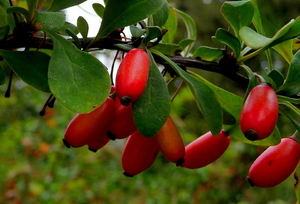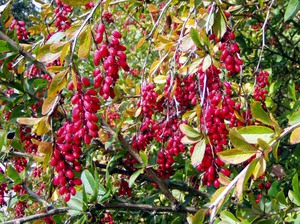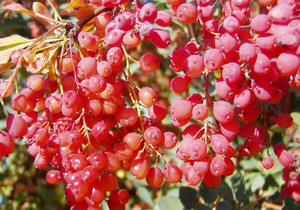 The barberry shrub is a member of a large genus of the Barberry family. These plants grow in the mountainous northern regions. The family includes about 170 varieties, many of which have been introduced into the culture. Gardeners are interested in barberry as a raw material for making drinks and medicines.
The barberry shrub is a member of a large genus of the Barberry family. These plants grow in the mountainous northern regions. The family includes about 170 varieties, many of which have been introduced into the culture. Gardeners are interested in barberry as a raw material for making drinks and medicines.
Also, this shrub, for its decorative properties, was not deprived of attention by lovers of beauty - there are many shades of leaves in barberry of different varieties, from ordinary green to purple and spotty with a border. Sizes also vary depending on the species. Some plants reach up to three meters in heightand although barberry may look like a tree, it is worth remembering that it is still a shrub.
The barberry bush is a plant of a group of deciduous, evergreen or semi-evergreen plants with thorns. Leaves are simple or leathery. Barberry flowers are small, with a rather strong aroma, golden or orange in color with the presence of shades of red. Flowers are usually collected in an inflorescence, but sometimes grow singly. This plant also attracts many insects such as bees, as the shrub is very rich in nectar. Also, the fruits of barberry have a huge variety in shape and color. This shrub is very unpretentious to the environment. He grows well in different soils, well adapted to urban conditions. For a bush hedge - the perfect solution.
Content
Barberry planting rules
 It is best to plant barberry in early spring, immediately after the soil thaws. However, it is necessary to plant the seedlings before the buds bloom. Sometimes they are planted in the fall, during abundant leaf fall.
It is best to plant barberry in early spring, immediately after the soil thaws. However, it is necessary to plant the seedlings before the buds bloom. Sometimes they are planted in the fall, during abundant leaf fall.
Due to its unpretentiousness to the surrounding conditions, barberry grows well in open areas, as it withstands drafts and strong winds well. This shrub can grow in partial shade, but some species in the open sun give a brighter color. Regarding the soil, the barberry feels more comfortable in a neutral type of soil, but still withstands some deviations in the composition of the earth.
If you plant barberry alone, then the distance between the bushes should be about two meters... If you plan to plant a hedge, then you need to plant a couple of bushes per linear meter. The holes for planting must be dug a couple of weeks before planting, approximately 40 by 40, for the hedge they make a trench 40 cm deep. To access more air to the roots, a layer of sand is placed at the bottom of the holes or trench.
If the soil composition is deviated from neutral, then its normalize by various methods. After lowering the seedling into the hole, sprinkle it with soil, crush it, and water it well. After all this, it is necessary to mulch the trunk circle. The aboveground part of the seedling is cut off, leaving only a part with three to five good buds.
Care rules
Everything related to planting and caring for barberry can be easily carried out even by a novice gardener, and it does not matter what type of this shrub will be planted. For example, there is many varieties with bitter fruits, which are grown only for decorative purposes, but they almost do not differ in care from species with edible berries. Therefore, having mastered the rules of caring for barberry once, you can grow many varieties in your garden.
There are several must-haves to do when caring for this unpretentious shrub:
 Regular watering. With an optimal amount of rainfall, barberry does not need watering, however, in dry times, soil moistening must be done weekly. You need to carefully monitor the amount of moisture in the roots. Since the plant is much more afraid of an excess of moisture than a lack.
Regular watering. With an optimal amount of rainfall, barberry does not need watering, however, in dry times, soil moistening must be done weekly. You need to carefully monitor the amount of moisture in the roots. Since the plant is much more afraid of an excess of moisture than a lack.- Weeding. It is necessary to remove weeds and young growth around the bush in time.
- Loosening the soil.
- Fertilizer. Those fertilizers that were applied during planting of barberry will be enough for a year. The next year, in the spring, they fertilize with nitrogen-containing substances. Then you need to do this once every three to four years. However, if the barberry plant is contained because of its fruits and beneficial properties, then it will be necessary to feed the bush with fertilizers containing phosphorus and potassium.
- Pruning. Along with the rest of the garden shrubs, dried, non-viable and thickening shoots are removed from the barberry during pruning. For the first time, the bush is pruned after the first year of life by about half, and then pruning is carried out twice a year. This operation is useful for the plant, both as a sanitary part and formative. Especially if a variety is grown that looks more like a tree. Types of low-growing barberries do not need to be trimmed.
How barberry reproduces
Exists several ways of breeding barberrybut in order to choose the right one, it is necessary to study the aspects of each.
 Reproduction by seeds. For this method of reproduction, it is necessary to collect ripe berries, remove the seeds from the fruit, place them in a potassium-manganese solution for several minutes and then dry them. In the fall, the seeds are planted in open soil to a depth of one centimeter. After the shoots appear and the first pair of true leaves grow, they are thinned out so that the distance between the seedlings is from 3 centimeters. Seedlings are grown at the planting site for about two years, then transplanted to a permanent place of growth. If a method of propagation by seeds was chosen, then you should know that first you need to prepare them for planting, for which you need to keep the seeds at a low temperature for two to five months. After planting in a permanent place, barberry bears fruit in a couple of years. But it should be remembered that cross-pollination is necessary for barberry to bear fruit, therefore it is necessary to plant several bushes of this plant on the site.
Reproduction by seeds. For this method of reproduction, it is necessary to collect ripe berries, remove the seeds from the fruit, place them in a potassium-manganese solution for several minutes and then dry them. In the fall, the seeds are planted in open soil to a depth of one centimeter. After the shoots appear and the first pair of true leaves grow, they are thinned out so that the distance between the seedlings is from 3 centimeters. Seedlings are grown at the planting site for about two years, then transplanted to a permanent place of growth. If a method of propagation by seeds was chosen, then you should know that first you need to prepare them for planting, for which you need to keep the seeds at a low temperature for two to five months. After planting in a permanent place, barberry bears fruit in a couple of years. But it should be remembered that cross-pollination is necessary for barberry to bear fruit, therefore it is necessary to plant several bushes of this plant on the site.- Propagation by cuttings. Cuttings are harvested in the morning hours in early summer. The leaves in the lower part of the segments are removed, in the upper part they are shortened by half. Then the cuttings are placed for a while in the root-forming substance. Further, it is necessary to rinse in water and plant in a greenhouse in moist soil of a certain composition. In the future, it will sometimes be necessary to ventilate the plants, and after they take root, the greenhouse dome can be removed altogether.
- Reproduction by layering. In the spring, you need to choose a good one-year-old shoot at the bottom of the bush, bend it to the ground and put it in a hole to a depth of twenty centimeters. Then you need to fix the shoot and cover it with earth. The top of the shoot must be left above the ground. In autumn, the shoot will give roots and it will be possible to plant it for growing.
- Division of the bush. This method is suitable for low species of barberry at the age of three to five years with a root collar, buried at least ten centimeters. In the spring, you need to dig up a bush and cut it into the required number of equal parts. This may require a pruner and a garden saw. This should be done carefully in order to minimize the injury to the plant.After that, you need to process the cuts with coal and plant them.
Wintering barberry
Young plants, up to five years old, need to be covered for the winter... This is especially true for evergreen varieties. If the bush is too large, it is covered in the same way as roses or hydrangea: the branches are firmly tied with a strong rope. Then I put a metal net around the bush, the height of which should be 10 centimeters higher than the bush. Dry leaves are poured between the bush and the net and the resulting shape is wrapped with material for covering plants.
The benefits of barberry
 The decorative advantages of the barberry served for the recognition of this shrub by all gardeners of the world. However, this plant can be grown not only to enjoy its beauty, but also for the huge number of its beneficial properties. In this regard, the most popular variety is common barberry... It is grown mainly for the berries that are used in the manufacture of various products.
The decorative advantages of the barberry served for the recognition of this shrub by all gardeners of the world. However, this plant can be grown not only to enjoy its beauty, but also for the huge number of its beneficial properties. In this regard, the most popular variety is common barberry... It is grown mainly for the berries that are used in the manufacture of various products.
Barberry fruits contain many vitamins, beneficial acids and mineral salts. The beneficial properties of this plant are also used in medicine for the treatment of various diseases and ailments. Moreover, any part of the shrub is suitable for treatment, but still leaves and fruits are mainly used.
Despite the great benefits, there is also a number of restrictions for its application... It is best to consult a specialist before use.


